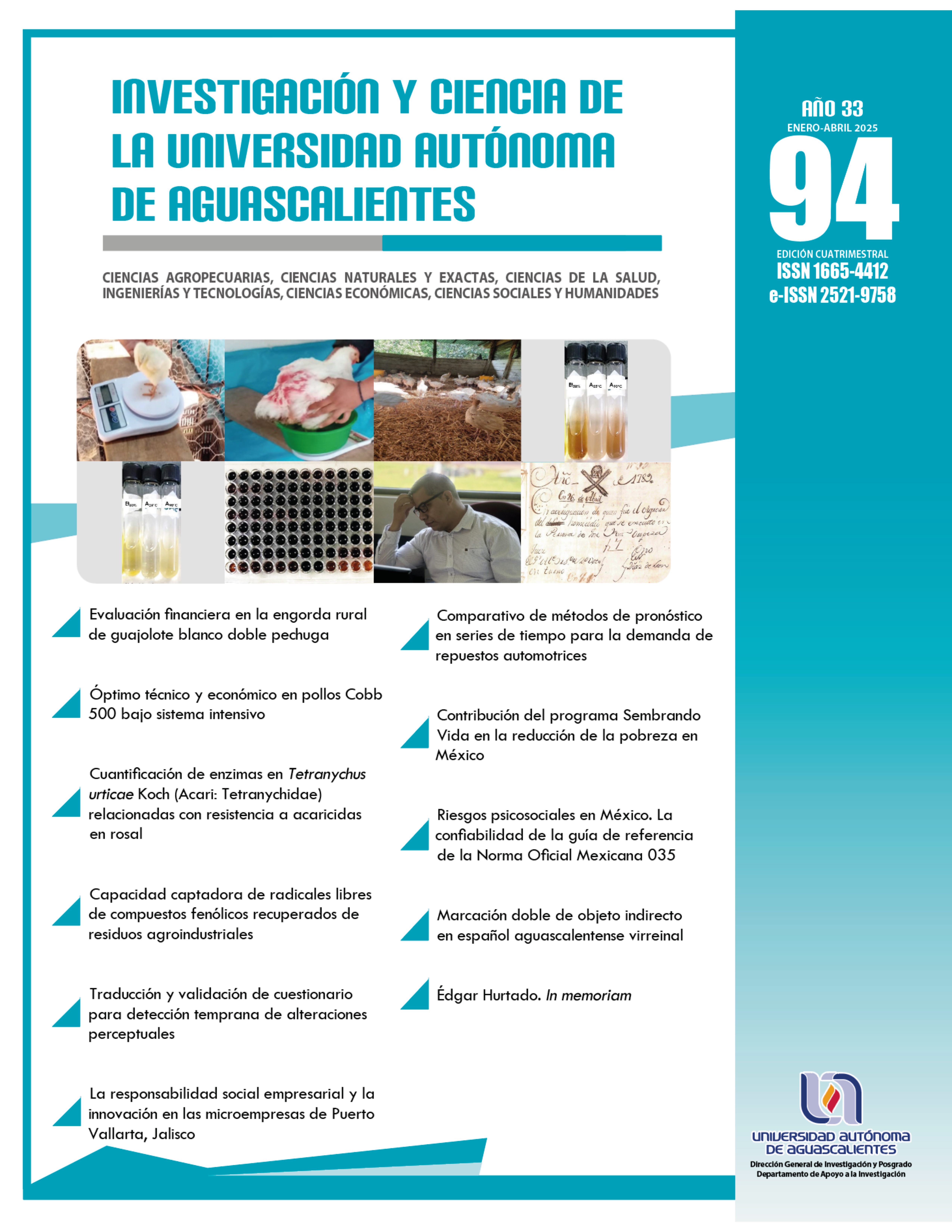Quantification of enzymes in Tetranychus urticae Koch (Acari: Tetranychidae) related to resistance to acaricides in rose bushes
DOI:
https://doi.org/10.33064/iycuaa2025945778Keywords:
Red spider, detoxification, mechanisms, pesticides, protein, rose bushAbstract
Specific acaricides have been generated to control T. urticae. However, biological aspects of this species have led to the development of resistance against these pesticides, one of the mechanisms involved is detoxification through enzymes. In this research, the levels of detoxifying enzymes that could confer resistance against acaricides in three populations of T. urticae from the rose-producing area in the south of the State of Mexico were quantified through biochemical tests. Five biochemical tests were performed on each population to determine the enzymatic levels of α-Est, β-Est, Oxid, GST and AChE. It is concluded that α-Est and β-Est are involved in the resistance of T. urticae to Abamectin, Oxid to Pyrethroids and Acequinocil, GST do not seem to be involved in the detoxification of acaricides and AChE confer resistance to Organophosphates.
Downloads
References
• Bass, C. I., Denholm, M. S., Williamson, A. and Nauen, R. (2015). The global status of insect resistance to neonicotinoid insecticides. Pesticides Biochemistry and Physiology, 121, 78-87. doi: 10.1016/j.pestbp.2015.04.004 DOI: https://doi.org/10.1016/j.pestbp.2015.04.004
• Bradford, M. M. (1976). A rapid and sensitive method for quantification of microgram quantities of protein utilizing the principles of protein-dye binding. Analytical Biochemistry, 72(1-2), 248-254. doi: 10.1016/0003-2697(76)90527-3 DOI: https://doi.org/10.1006/abio.1976.9999
• Brogdon, W. G. (1984). Mosquito protein microassay-1: Protein determinations from small portions of single-mosquito homogenates. Comparative Biochemistry and Physiology, 79(3), 457-459. doi: 10.1016/0305-0491(84)90405-X DOI: https://doi.org/10.1016/0305-0491(84)90405-X
• Brogdon, W. G. (1988). Microassay of acetylcholinesterase activity in small portions of single mosquito homogenates. Comparative Biochemistry and Physiology, 90(1), 145-150. doi: 10.1016/0742-8413(88)90110-7 DOI: https://doi.org/10.1016/0742-8413(88)90110-7
• Brogdon, W. G. and Barber A. (1987). Microplate assay of acetylcholinesterase inhibition kinetics in single mosquitoes homogenates. Pesticides Biochemistry and Physiology, 29(3), 252-259. doi: 10.1016/0048-3575(87)90155-6 DOI: https://doi.org/10.1016/0048-3575(87)90155-6
• Brogdon, W. G. and Barber, A. M. (1990). Microplate assay of glutathione s-transferase activity for resistance detection in single mosquito triturates. Comparative Biochemistry and Physiology, 96(2), 339-342. doi: 10.1016/03050491(90)90385-7 DOI: https://doi.org/10.1016/0305-0491(90)90385-7
• Brogdon, W. G and Dickinson, M. C. (1983). A microassay system for measuring esterase activity and protein concentration in small samples and in hig-pressure liquid chromatography eluate fractions. Analytical Biochemistry, 131(2), 499-503. doi: 10.1016/0003-2697(83)90204-X DOI: https://doi.org/10.1016/0003-2697(83)90204-X
• Brogdon, W. G., McAllister, J. C. and Vulule, J. (1997). Heme peroxidase activity measured in single mosquitoes identifies individuals expressing an elevated oxidase for insecticide resistance. Journal of the American Mosquito Control Association,13(3), 233-237. https://www.biodiversitylibrary.org/content/part/JAMCA/JAMCA_V13_N3_P233-237.pdf
• Dary, O. Georghiou, G. P., Parsons, E. and Pasteur, N. (1990). Microplate adaptation of Gomori’s assay for quantitative determination of general esterase activity in single insects. Journal Economic Entomology, 83(6), 2187-2192. doi: 10.1093/jee/83.6.2187 DOI: https://doi.org/10.1093/jee/83.6.2187
• De Rouck, S., Inak, E., Dermauw, W. and Van, L. T. (2023). A review of the molecular mechanisms of acaricide resistance in mites and ticks. Insect Biochemistry and Molecular Biology, 159, 103981. doi: 10.1016/j.ibmb.2023.103981 DOI: https://doi.org/10.1016/j.ibmb.2023.103981
• Díaz, A. V. K., Rodríguez, M. J. C., Lagunés, T. A., Aguilar, M. S., Tejeda, R. M. A. and Silva, A. G. (2019). Resistance to Abamectin in Field Population of Tetranychus urticae Koch (Acari: Tetranychidae) Associated with Cut Rose from State of Mexico, Mexico. Florida Entomologist, 102(2), 428-430. doi: 10.1653/024.102.0222 DOI: https://doi.org/10.1653/024.102.0222
• Farahani, S., Reza, B. A. and Amiri, A. (2021). Variable susceptibility in populations of Tetranychus urticae Koch (Acari: Tetranychidae) to propargite and chlorpyrifos. J. Crop Prot, 10(1), 139-150. https://jcp.modares.ac.ir/article-3-43043-en.pdf
• Hu, Z. D. X., Lin, H. Y., Chen, H., Li, Z., F., Yin, F. and Feng, X. (2014). Identification of a novel cytochrome P450 gene, CYP321E1 from the diamondback moth, Plutella xylostella (L.) and RNA interference to evaluate its role in chlorantraniliprole resistance. Bulletin of Entomological Research, 104(6), 716-723. doi: 10.1017/S0007485314000510 DOI: https://doi.org/10.1017/S0007485314000510
• IRAC. (2024). Mode of action classification scheme. v11.1. https://irac-online.org/documents/moa-classification/?ext=pdf
• Khanjani, M., Saberfar, F., Mirzaie, A. A. and Sheikhi, G. A. (2020). Resistance mechanisms of the two-spotted spider mite, Tetranychus urticae (Acari: Tetranychidae) populations to fenpyroximate. J. Crop Prot, 9(2), 337-345. http://jcp.modares.ac.ir/article-3-39883-en.html
• Labrou, N. E., Papageorgiou, A. C., Pavli, O. and Flemetakis, E. (2015). Plant GSTome: structure and functional role in xenome network and plant stress response de las plantas. Current Opinion in Biotechnology, 32, 186-194. doi: 10.1016/j.copbio.2014.12.024 DOI: https://doi.org/10.1016/j.copbio.2014.12.024
• Liu, Z., Wu, F., Lijuan, Z. W. L. and Huang, J. (2022). Molecular Mechanisms Underlying Metabolic Resistance to Cyflumetofen and Bifenthrin in Tetranychus urticae Koch on Cowpea. Int. J. Mol. Sci, 23(24), 16220. doi: 10.3390/ijms232416220 DOI: https://doi.org/10.3390/ijms232416220
• Mota, S. D. and Wise J. C. (2024). The Arthropod Pesticide Resistance Database. Michigan State University. http://www.pesticideresistance.org
• Pavlidi, N., Khalighi, M., Myridakis, A., Dermauw, W., Wybouw, N., Tsakireli, D., Stephanou, E. G., Labrou, N. E., Vontas, J., Leeuwen, T. V. (2017). A glutathione-S-transferase (TuGSTd05) associated with acaricide resistance in Tetranychus urticae directly metabolizes the complex II inhibitor cyflumetofen. Insect Biochemistry and Molecular Biology, 80,101-115. doi: 10.1016/j.ibmb.2016.12.003 DOI: https://doi.org/10.1016/j.ibmb.2016.12.003
• Solmaz, E., Çevik B. and Ay, R. (2020). Abamectin resistance and resistance mechanisms in Tetranychus urticae populations from cut flowers greenhouses in Turkey. International Journal of Acarology, 46 (2), 94-99. doi: 10.1080/01647954.2020.1727009 DOI: https://doi.org/10.1080/01647954.2020.1727009
• Van, L. T. and Dermauw, W. (2016). The Molecular Evolution of Xenobiotic Metabolism and Resistance in Chelicerate Mites. Annual Review of Entomology, 61 (1), 475-498. doi:10.1146/annurev-ento-010715-023907 DOI: https://doi.org/10.1146/annurev-ento-010715-023907
• Yamamoto, K. and Yamada, N. (2016). Identification of a diazinon-metabolizing glutathione S-transferase in the silkworm, Bombyx mori. Scientific Reports, 6(1), 30073. doi: 10.1080/01647954.2014.944932 DOI: https://doi.org/10.1038/srep30073
• Yorulmaz, S. S. y Saritaş, E. (2014). Acequinocyl resistance in Tetranychus urticae Koch (Acari: Tetranychidae): inheritance, synergists, cross-resistance and biochemical resistance mechanisms. International Journal of Acarology, 40(6), 428-435. doi: 10.1080/01647954.2014.944932 DOI: https://doi.org/10.1080/01647954.2014.944932
Downloads
Published
How to Cite
License
Copyright (c) 2025 Lisett Romero-Pavón, Ernesto Cerna-Chávez, Yisa María Ochoa-Fuentes, Agustín Hernández-Juárez, Rafael Alvarado-Navarro

This work is licensed under a Creative Commons Attribution-NonCommercial-ShareAlike 4.0 International License.
Las obras publicadas en versión electrónica de la revista están bajo la licencia Creative Commons Atribución-NoComercial-CompartirIgual 4.0 Internacional (CC BY-NC-SA 4.0)









